Joost Vennekens
VERUS-LM: a Versatile Framework for Combining LLMs with Symbolic Reasoning
Jan 24, 2025



Abstract:A recent approach to neurosymbolic reasoning is to explicitly combine the strengths of large language models (LLMs) and symbolic solvers to tackle complex reasoning tasks. However, current approaches face significant limitations, including poor generalizability due to task-specific prompts, inefficiencies caused by the lack of separation between knowledge and queries, and restricted inferential capabilities. These shortcomings hinder their scalability and applicability across diverse domains. In this paper, we introduce VERUS-LM, a novel framework designed to address these challenges. VERUS-LM employs a generic prompting mechanism, clearly separates domain knowledge from queries, and supports a wide range of different logical reasoning tasks. This framework enhances adaptability, reduces computational cost, and allows for richer forms of reasoning, such as optimization and constraint satisfaction. We show that our approach succeeds in diverse reasoning on a novel dataset, markedly outperforming LLMs. Additionally, our system achieves competitive results on common reasoning benchmarks when compared to other state-of-the-art approaches, and significantly surpasses them on the difficult AR-LSAT dataset. By pushing the boundaries of hybrid reasoning, VERUS-LM represents a significant step towards more versatile neurosymbolic AI systems
Enhancing Computer Vision with Knowledge: a Rummikub Case Study
Nov 27, 2024


Abstract:Artificial Neural Networks excel at identifying individual components in an image. However, out-of-the-box, they do not manage to correctly integrate and interpret these components as a whole. One way to alleviate this weakness is to expand the network with explicit knowledge and a separate reasoning component. In this paper, we evaluate an approach to this end, applied to the solving of the popular board game Rummikub. We demonstrate that, for this particular example, the added background knowledge is equally valuable as two-thirds of the data set, and allows to bring down the training time to half the original time.
EmoCAM: Toward Understanding What Drives CNN-based Emotion Recognition
Jul 19, 2024



Abstract:Convolutional Neural Networks are particularly suited for image analysis tasks, such as Image Classification, Object Recognition or Image Segmentation. Like all Artificial Neural Networks, however, they are "black box" models, and suffer from poor explainability. This work is concerned with the specific downstream task of Emotion Recognition from images, and proposes a framework that combines CAM-based techniques with Object Detection on a corpus level to better understand on which image cues a particular model, in our case EmoNet, relies to assign a specific emotion to an image. We demonstrate that the model mostly focuses on human characteristics, but also explore the pronounced effect of specific image modifications.
Answer Set Programming for Flexible Payroll Management
Mar 19, 2024Abstract:Payroll management is a critical business task that is subject to a large number of rules, which vary widely between companies, sectors, and countries. Moreover, the rules are often complex and change regularly. Therefore, payroll management systems must be flexible in design. In this paper, we suggest an approach based on a flexible Answer Set Programming (ASP) model and an easy-to-read tabular representation based on the Decision Model and Notation (DMN) standard. It allows HR consultants to represent complex rules without the need for a software engineer, and to ultimately design payroll systems for a variety of different scenarios. We show how the multi-shot solving capabilities of the clingo ASP system can be used to reach the performance that is necessary to handle real-world instances.
FindingEmo: An Image Dataset for Emotion Recognition in the Wild
Feb 02, 2024Abstract:We introduce FindingEmo, a new image dataset containing annotations for 25k images, specifically tailored to Emotion Recognition. Contrary to existing datasets, it focuses on complex scenes depicting multiple people in various naturalistic, social settings, with images being annotated as a whole, thereby going beyond the traditional focus on faces or single individuals. Annotated dimensions include Valence, Arousal and Emotion label, with annotations gathered using Prolific. Together with the annotations, we release the list of URLs pointing to the original images, as well as all associated source code.
An epistemic logic for modeling decisions in the context of incomplete knowledge
Dec 18, 2023Abstract:Substantial efforts have been made in developing various Decision Modeling formalisms, both from industry and academia. A challenging problem is that of expressing decision knowledge in the context of incomplete knowledge. In such contexts, decisions depend on what is known or not known. We argue that none of the existing formalisms for modeling decisions are capable of correctly capturing the epistemic nature of such decisions, inevitably causing issues in situations of uncertainty. This paper presents a new language for modeling decisions with incomplete knowledge. It combines three principles: stratification, autoepistemic logic, and definitions. A knowledge base in this language is a hierarchy of epistemic theories, where each component theory may epistemically reason on the knowledge in lower theories, and decisions are made using definitions with epistemic conditions.
Knowledge-Based Support for Adhesive Selection: Will it Stick?
Nov 07, 2023



Abstract:As the popularity of adhesive joints in industry increases, so does the need for tools to support the process of selecting a suitable adhesive. While some such tools already exist, they are either too limited in scope, or offer too little flexibility in use. This work presents a more advanced tool, that was developed together with a team of adhesive experts. We first extract the experts' knowledge about this domain and formalize it in a Knowledge Base (KB). The IDP-Z3 reasoning system can then be used to derive the necessary functionality from this KB. Together with a user-friendly interactive interface, this creates an easy-to-use tool capable of assisting the adhesive experts. To validate our approach, we performed user testing in the form of qualitative interviews. The experts are very positive about the tool, stating that, among others, it will help save time and find more suitable adhesives. Under consideration in Theory and Practice of Logic Programming (TPLP).
IDP-Z3: a reasoning engine for FO
Feb 11, 2022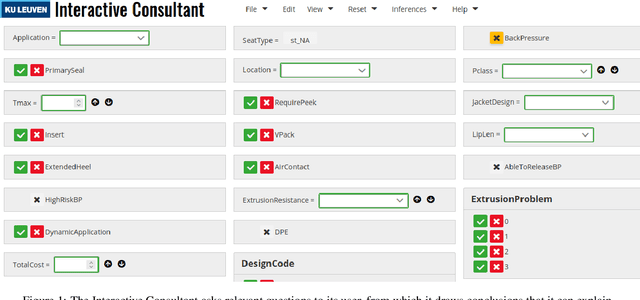


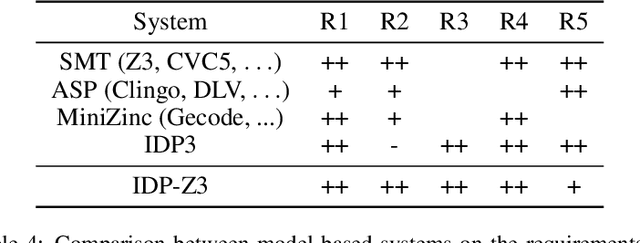
Abstract:An important sign of intelligence is the capacity to apply a body of knowledge to a particular situation in order to not only derive new knowledge, but also to determine relevant questions or provide explanations. Developing interactive systems capable of performing such a variety of reasoning tasks for the benefits of its users has proved difficult, notably for performance and/or development cost reasons. Still, recently, a reasoning engine, called IDP3, has been used to build such systems, but it lacked support for arithmetic operations, seriously limiting its usefulness. We have developed a new reasoning engine, IDP-Z3, that removes this limitation, and we put it to the test in four knowledge-intensive industrial use cases. This paper describes FO(.) (aka FO-dot), the language used to represent knowledge in the IDP3 and IDP-Z3 system. It then describes the generic reasoning tasks that IDP-Z3 can perform, and how we used them to build a generic user interface, called the Interactive Consultant. Finally, it reports on the four use cases. In these four use cases, the interactive applications based on IDP-Z3 were capable of intelligent behavior of value to users, while having a low development cost (typically 10 days) and an acceptable response time (typically below 3 seconds). Performance could be further improved, in particular for problems on larger domains.
Problife: a Probabilistic Game of Life
Jan 24, 2022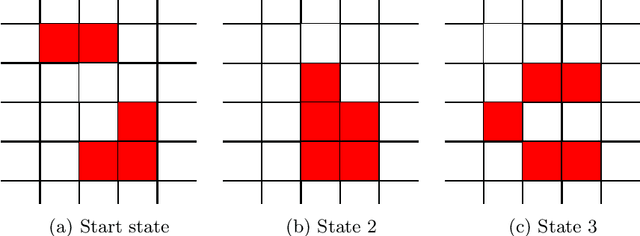
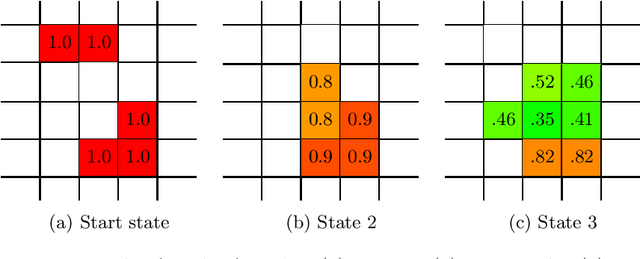


Abstract:This paper presents a probabilistic extension of the well-known cellular automaton, Game of Life. In Game of Life, cells are placed in a grid and then watched as they evolve throughout subsequent generations, as dictated by the rules of the game. In our extension, called ProbLife, these rules now have probabilities associated with them. Instead of cells being either dead or alive, they are denoted by their chance to live. After presenting the rules of ProbLife and its underlying characteristics, we show a concrete implementation in ProbLog, a probabilistic logic programming system. We use this to generate different images, as a form of rule-based generative art.
Compressing Word Embeddings Using Syllables
Jan 13, 2022
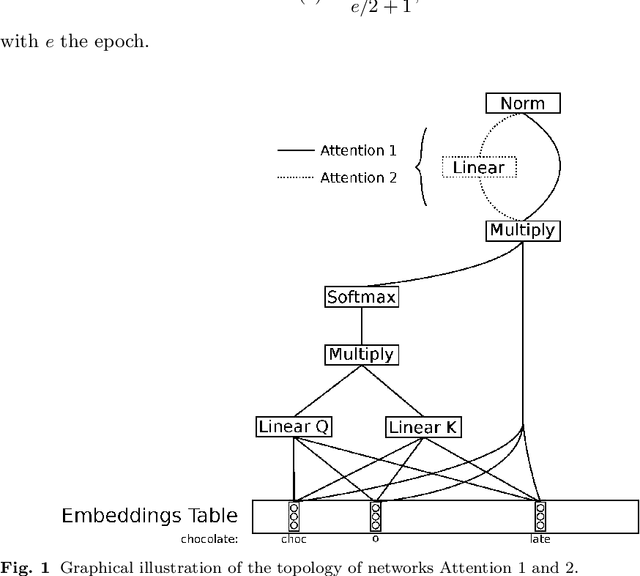

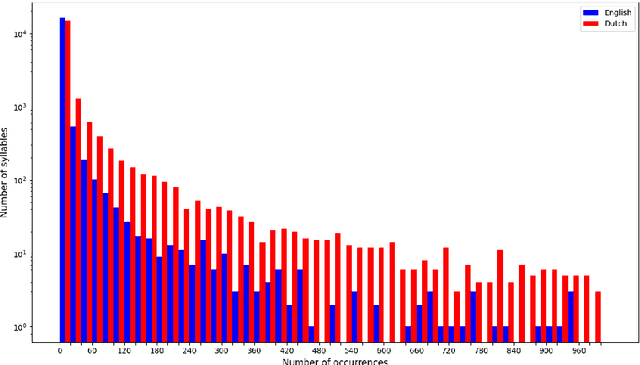
Abstract:This work examines the possibility of using syllable embeddings, instead of the often used $n$-gram embeddings, as subword embeddings. We investigate this for two languages: English and Dutch. To this end, we also translated two standard English word embedding evaluation datasets, WordSim353 and SemEval-2017, to Dutch. Furthermore, we provide the research community with data sets of syllabic decompositions for both languages. We compare our approach to full word and $n$-gram embeddings. Compared to full word embeddings, we obtain English models that are 20 to 30 times smaller while retaining 80% of the performance. For Dutch, models are 15 times smaller for 70% performance retention. Although less accurate than the $n$-gram baseline we used, our models can be trained in a matter of minutes, as opposed to hours for the $n$-gram approach. We identify a path toward upgrading performance in future work. All code is made publicly available, as well as our collected English and Dutch syllabic decompositions and Dutch evaluation set translations.
 Add to Chrome
Add to Chrome Add to Firefox
Add to Firefox Add to Edge
Add to Edge